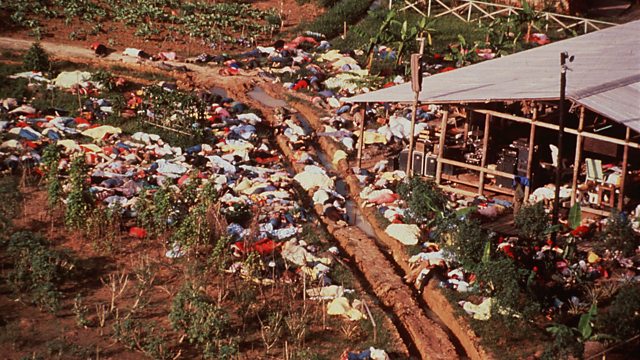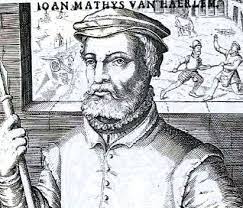Fanaticism and holy men: two cases in which madness was triggered by an excess of religious fanaticism

Italy was deeply affected by the recent news story in Altavilla Milicia, in the province of Palermo, where religious fanaticism, bordering on madness, was the basis of a horrendous crime and the extermination of a family.
Yet history is full of episodes of pure religious and fanatical madness, which ended very badly, with unspeakable massacres amidst unspeakable acts. We want to present to you two historical cases that remind you, on a large scale, of what obsession without critical sense can cause. We talk about the 17th century Munster Massacre and the 1978 Guyana Peoples Temple case.
Muster 1535
Mustern was a Catholic bishop's seat in the 17th century, but the city was also populated by many Lutherans and other Protestants. Bishop Franz von Waldeck was not loved at all, so the basis for a sort of small revolution was already present. The Anabaptists managed to gain a majority in the city council and expelled the bishop, thus calling in preachers of their own religion. When the Anabaptist "Prophets" Jan Bockelson, Jan Matthys and Bernhard Knipperdolling arrived , they managed to spread Anabaptism in a widespread way and to create such an exaltation of the masses that they expelled all the citizens, Catholics and Lutherans, who had not adhered to their I think, and it went well because Matthys had thought of putting them all to the sword. Those who remained were forced to rename themselves and Knipperdolling became burgomaster, assisted by Bernhard Rothmann, a former Moldovan Lutheran pastor followed in the city.
Matthys proclaimed Munster the New Zion on earth and invited all Anabaptists to flock to Münster: around 2,500 faithful responded to the call, including the two brothers and former priests Bernhard and Hinrich Krechting, who would later take on official roles in the government of the city . Inside the city the leaders divided the tasks: Matthys assumed command of the theocratic dictatorship, Rothmann took care of propaganda and Knipperdolling took care of the defense. On Easter day, 4 April 1534, the date Matthys predicted for the end of the world, he led a crazy sortie with just 20 companions against the bishop's troops, who had begun a gentle siege of the city, and even tried to harangue the soldiers to go over to the side of the besieged, but was killed by an officer with a sword blow to the chest. The world, among other things, did not end.
Once the prophet Matthys fell, it could have been hypothesized that the entire crazy complex he had concocted would collapse but instead Bockelson took advantage of it to seize power: he was invested with the title of prophet of Zion following an extremely "appropriate" dream of Knipperdolling. Taken over, Bockelson. Unfortunately he proved to be even more fanatical and bloodthirsty than Matthys himself and did not give up the usual method of imposing unpleasant decisions on the population, presenting them as an unquestionable part of his mystical delirium. Following the first vision he announced that the government of the city would be managed by a council of twelve elders, that very severe new laws would be passed, and that any insubordination would be punished by death.
From July 1534 compulsory polygamy was introduced and Bockelson married 15 wives, all young and beautiful, including Matthys' widow, Divara, while Rothmann was content with 9 wives and so on. The provision, imposed by force, met with increasing resistance: a conspiracy was bloodily repressed and all the women who refused forced marriage were horribly tortured and killed. In addition to this, Bockelson had the city's bell towers torn down because of open defiance of the Almighty and appointed three children as judges.
In September, a Bockelson loyalist, a certain Dusentschnuer, said that he had dreamed that God communicated to him the designation of B. as the new King David of the kingdom of the New Jerusalem. The former accepted the divine appointment by threatening those who opposed it with death. He then had himself crowned, with his queen Divara at his side, lavishly surrounded by dignitaries and bodyguards: a great defeat for the sincere humility and poverty of the first Anabaptists!
There were several conspiracies to overthrow the king, one of which also saw Knipperdolling as the protagonist, and there were numerous executions. By now B.'s bloody follies were the order of the day: once he called a banquet for everyone, where he personally beheaded a recently captured mercenary of Bishop von Waldeck, and shortly afterwards, as if nothing had happened, he celebrated the Holy Supper !
All this led to a mobilization of the principalities in the area, terrified by what was happening in the city and in the end the siege became serious, so much so that no supplies could pass through. The citizens first ran out of supplies, but on August 24, 1535, a citizen opened the gates to the city. The minions who entered proceeded with extreme harshness. Bockelson offered to reconvert and even help convert the remaining Anabaptists, but he was not believed and so, in 17th century style, he was tortured, killed and his corpse displayed in a cage.
What had happened in Munster led to a reaction among the Anabaptists and many followed the preacher Simons Menno by becoming Mennonites, that is, total pacifists.
Jim Jones and the Jamestown Massacre
The Jonestown Massacre was, prior to 9/11, the largest incident of intentional civilian death in American history. More than 900 people died, many children. It was also a devastating cultural trauma: the end of the last remnants of a certain type of idealism of the 1960s and radicalism of the 1970s.

Jim Jones was born into a poor family in Indiana. Described as an intelligent and strange child, Jones was instinctively drawn to religion, particularly charismatic Christian traditions such as Pentecostalism. He made his way as a street preacher and, unusually for the time and place, was a passionate supporter of racial equality and immediately very close to the positions of the radical left of the time
He called his nascent church the People's Temple and preached a mix of left-wing egalitarianism, New Age and Christianity. People's Temple advocated socialism and community life and was racially integrated to an exceptional standard rarely equaled since.
In 1965, when Jones was in his 30s, he ordered the Peoples Temple moved to California. He distanced himself from traditional Christian teachings, describing himself in messianic terms and claiming to be the reincarnation of figures such as Christ and Buddha. He also argued that his goal had always been communism and that religion was only a tool to make Marxism more palatable.
In the 1970s, the Peoples Temple, now based in San Francisco, gained considerable political influence. Jones's ferocity towards the oppressed earned him the admiration of left-wing icons such as Angela Davis and Harvey Milk and the support of groups such as the Black Panthers: a tragically misguided political affinity, given that more than two-thirds of the victims of Jonestown were African Americans.
The People's Temple was useful, because it was able to mobilize many serious-looking people reliably, something very useful for the demonstrations of the time.
However, there were already signs of a sinister current in the People's Temple. Followers were expected to dedicate themselves completely to the church's utopian project: giving up their personal wealth, working long hours without pay for the church, and often cutting off contact with their families. They were expected to raise their children within the community. As a show of commitment, Peoples Temple members were asked to sign false testimonies that they had molested their children, which the church kept for blackmail.
In his 1980 study of Jonestown, the writer Shiva Naipaul, younger brother of VS Naipaul, argued that the Peoples Temple was at heart a fundamentalist religious project – “obsessed with sin and images of apocalyptic destruction, authoritarian in its deepest impulses, who thought instinctively in terms of the saved and the damned.”
Jones, who had long believed that the United States was in danger of an imminent nuclear holocaust, was looking for a place where his church would be "safe" during an apocalyptic event. A magazine article alleging abuse at the Peoples Temple spurred Jones' desire to move. He chose Guyana, a former British colony in South America whose socialist regime was politically favorable.
In 1977, the Peoples Temple moved its headquarters to a remote wilderness area in Guyana. Here, Jones declared, they could build a utopian society without government or media interference. Struggling against an oppressive tropical climate and limited resources, they began converting the dense jungle into a functioning agricultural commune, soon known as “Jonestown.”
The church broadcast Jones' rambling monologues to the residents of Jonestown via megaphone as they worked. In the evenings they attended compulsory propaganda classes. Jones' order was enforced by armed guards called the “Red Brigade”.
Jonestown had no reason to expect interference from Guyana, a “cooperative republic” whose government willingly ignored signs of the sect's authoritarian and paranoid tendencies. In the United States, however, the parents of the Jonestown residents, concerned about the strange letters, or lack of letters, they were receiving from their children, had pressured the government to investigate.
After a U.S. family obtained a custody order for a Jonestown child, the paranoia intensified. The commune became an armed camp, surrounded by volunteers with guns and machetes who threatened to fight strangers to the death.
During the (fictional) siege, Black Panthers Huey Newton and Angela Davis spoke to the residents of Jonestown by radio to express solidarity. Davis told the residents of Jonestown that they were in the vanguard of the revolution and that they were right to resist what she called “a deep conspiracy” against them.
At that time, exercises called "white nights" began in Jonestown, in which the inhabitants practiced committing mass suicides.
At the request of concerned family members in the United States, California Congressman Leo Ryan organized a delegation of journalists and others for a fact-finding mission to Jonestown.
The delegation arrived in Jonestown on November 17, 1978 and managed to visit the commune, but the visit was cut short when a person tried to stab the congressman. The delegation returned to the airstrip, accompanied by a dozen Jonestown residents who had asked to leave the commune and escorted by Jones' deputies.
The delegates never managed to take off. As they boarded the planes, their escorts drew their weapons and opened fire. They killed Ryan, peppering his body with bullets to make sure, and killed four others, including two photographers who had filmed the attack before dying. Wounded survivors ran or dragged themselves, bleeding, into the forest. One of Ryan's aides, Jackie Speier, survived five gunshots and became a congresswoman.
Returning to Jonestown, Jones announced that the time had come to embark on one last “white night.” To quell dissent, he told residents that Congressman Ryan had already been killed, sealing the community's fate and making "revolutionary suicide" the only possible outcome.
The residents of Jonestown, some accepting and serene, others probably coerced, lined up to receive cups of cyanide punch and syringes. The children – more than 300 – were poisoned first, and crying and wailing can be heard in audio recordings of the community, later recovered by the FBI.
When the Guyanese troops reached Jonestown the following morning, they discovered an eerily silent landscape, frozen in time and littered with bodies. A small number of survivors emerged, mostly people who had hidden during the poisoning. An elderly woman, who had been asleep the entire time, woke up to find that everyone was dead. Jones was found dead from an apparently self-inflicted gunshot.

Thanks to our Telegram channel you can stay updated on the publication of new Economic Scenarios articles.
The article Fanaticism and holy men: two cases in which madness was triggered by excessive religious fanaticism comes from Economic Scenarios .
This is a machine translation of a post published on Scenari Economici at the URL https://scenarieconomici.it/fanatismo-e-santoni-due-casi-in-cui-la-follia-e-stata-innescata-dallecceso-religioso/ on Sat, 17 Feb 2024 12:56:43 +0000.

